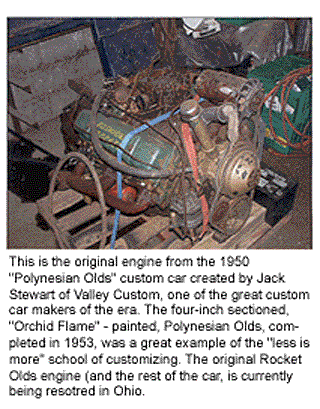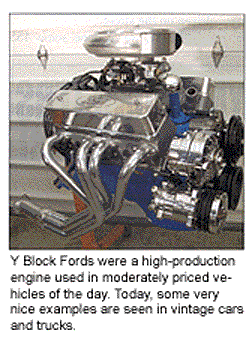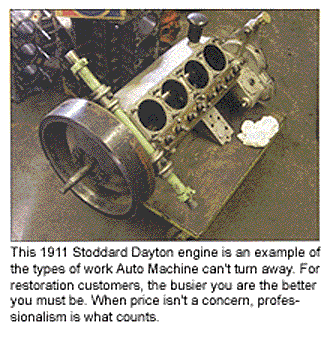There have been tremendous and significant changes in vehicle design since the first gasoline-powered vehicle hit the streets of America back in the early 1890s. Such advancements as fuel injection, radial tires, variable valve train technology, roller cams and front-wheel drive, among many others, have made cars easier to maintain, safer to drive and more convenient to own.
But for all the advancements, one thing hasn’t changed: Americans have always – and likely always will – have a love affair with the car. Not necessarily the car they’re driving now, but the one they had in high school or college – or, more likely, the car they WISH they had.
“As a whole, the restoration market is very much alive and doing well,” says Ernie Silvers, chairman of the Antique Restoration Market Organization (ARMO), a committee of the Specialty Equipment Market Association (SEMA). “America’s love for old cars seems to be as strong as ever with no end in sight. America loves nostalgia and the cars that go with it. And as long as parts are available, older engines will be rebuilt.”
An Affair To Remember
To ask someone to describe their first car is to ask them to recall their youth. It seems that no matter how bad that first car may have been – how rusty its floorboards, dusty its rear window shelf or musty its interior, we have a certain fondness for that old car. In our youth, it represented freedom, and hindsight being what it is, we tend to remember all the great times we had in that car. We also tend to forget the nights it left us stranded in a parking lot…

Luckily, with age comes that selective memory; as well, in many cases, as the financial resources to simply “rewrite history.” As industry experts and engine builders agree, the restoration business continues to offer engine builders a great opportunity for success.
According to SEMA, retail restoration expenditures exceeded $1.3 billion in 2004. Accessories accounted for 44 percent of this number and hardcore parts accounted for 25 percent of the total. This figure does not include labor charges from engine or machine shops and may also include other non-engine parts – but the potential is obvious.
According to SEMA, the restoration market is generally composed of four broad groups: antiques manufactured before 1920; domestic vehicles manufactured from 1920 to World War II (classified as antiques, as well); post-World War II vehicles built through the ’50s into the ’70s (also called classics); and foreign vehicles.
Of course, within each of these broad categories, vehicle owners may have distinctly different ideas of what they call a “restoration.” One option is a “show” restoration, in which case the engine (and the vehicle) is often restored to perfection with a total disregard for cost. Often referred to as a “100-point” resto, for the possible points available from most Concours judges, these restored vehicles are seldom, if ever, driven on the street.
“Lately, we’ve done some 455 Pontiacs that the owners wanted to be restored to original,” says John DeBates of Auto Machine Inc., St. Charles, IL. “In this case, that means we pay attention to every detail about the engine, from the type of bolts used, to the exact OE engine paint.”
DeBates says to some customers, that type of detail is important, and so he is happy to oblige them…but that doesn’t mean it’s an easy process. “Sometimes they want the paint to be applied in a certain way. There are certain fussy car collectors who insist that a certain amount and location of overspray on other parts is required for authenticity. In these cases, I’ll say, ‘paint it yourself’ – because I don’t want to do it wrong!”

According to Gary Schmidt of Wheeler Racing Engines, Blaine, MN, the degree of restoration usually depends on one thing – cash. “Sometimes along the way, the owner of a project realizes that to make a vehicle a numbers-matching car in every way is going to get pretty expensive.”
Cost is one reason that another type of restoration may be desired. A “street” restoration is one that usually includes less attention to such details as matching numbers and more modifications for performance, durability and driveability.
“What we hear from customers is often ‘Sure, I want it to look like a 1970 Charger, but I want it to drive, stop and turn like a brand new car,” says John Balow, Muscle Car Restorations, Chippewa Falls, WI. “They want it to look like it COULD have been, not necessarily how it actually was.”
Balow says customers will often come to him with a vague idea of what they want from an engine and not much of a clue as to how to get it. “They’ll say ‘I want a car that’s a ground pounding stump puller that I can drive on the street – what do I need?'” Balow says in some cases, the customer ISN’T right.
What he’s learned over the years, Balow says, is that, quite frankly, the high horsepower engines many customers think they want are really not going to be their best choice, especially if they want to use the car on the street.
“Most customers think they need the high horsepower motor for bragging rights. What ends up happening is that the extra horsepower is in the upper rpm range and they never see it,” Balow says.
“The trend isn’t toward big horsepower numbers, it’s toward big torque numbers. Combine that with an overdrive transmission, the right torque converter and gear ratio and you’ll meet the customer’s interests,” Balow explains.
Some people want a pristine restoration that will never get driven, some want a good looking engine that sounds loud but isn’t necessarily historically accurate. And others want something even more different. Meeting the needs of the customers – no matter how strange those may seem – is imperative if you want to succeed in this segment of the industry, explains DeBates.
“We worked with the Chicago Museum of Science and Industry to restore an early Stoddard-Dayton,” he says. “The thing is, they wanted it to look old – they wanted it completely restored on the inside, but they didn’t want the dirt and grease on the outside disturbed!”
DeBates says this request made for an extremely challenging restoration and, while his shop had to clean it in order to do the machining, part of the process involved getting it dirty once again.
“In this case, they weren’t going to restore the rest of the car to a ‘brand new’ condition – they wanted to display the car as it was used in the 1910s…they just wanted it to look real,” DeBates says.
Niche? Natch!
To say that the restoration business offers a wealth of opportunity is an understatement. The number of different types of vehicles you can find to restore are staggering and are limited only by your imagination and interest.
Wheeler Racing’s Schmidt says his company has developed its restoration niche (small- and big-block Chevy and big block Chryslers) the old-fashioned way – by building the original and now rebuilding it.
“We’ve primarily been a race engine builder for the past 40-plus years,” says Schmidt, “and we built a lot of motors for muscle cars back in their original days. These were often for Stock Eliminator and Super Stock drag racing back in the ’60s, so now that we’re restoring them we have a pretty good customer base. But we’re pretty strictly focused on the type of restorations we do.”
Wheeler’s niche is restoring vintage racing engines; others may choose a more obscure route.
“More and more car enthusiasts are looking for that ‘something different’ to make their car cooler than everyone else’s,” says ARMO’s Silvers. “The current trend is choosing to restore the vehicle’s original engine. Therefore, nostalgic engines are hotter than ever. For instance, flathead Ford/Mercury, flathead Cadillac, Nail-head Buick and Hemi motors have become more and more common at car shows and cruises.”

The restoration market extends even further from the ordinary than you might imagine. “There are a lot of different vehicles out there, not just cars,” says DeBates. “We do a lot of antique tractor restorations as well. Here in the Midwest, farm tractors are popular, even with city people who have never plowed a field in their lives. They take them to farm shows, county fairs and local parades.”
Looking Ahead
Some engine builders may be reluctant to tackle an engine restoration because they think old powerplants are too complex or parts aren’t available. Both of these concerns, veterans say, are unfounded.
“Granted, taking advantage of specialization requires you to learn some new things – or perhaps relearn some old forgotten things,” says Engine Builder contributor and vintage engine expert Doc Frohmader. “But getting into a new old engine should be no different than getting into a new new engine.”
DeBates agrees. “With a lot of what you’ll open up, you’ll look at these old engines and think ‘I’ve never seen that before…’ when in fact, you have.”
He continues: “I used to think roller cams came from the ’50s and ’60s – then I started seeing them in motors from the ’20s. Variable cam timing? It was done on engines even at the beginning.”
DeBates explains that in many cases, early vehicle manufacturers had the luxury of trying innovative engine and component designs. However, because they didn’t have the metallurgy or manufacturing precision to reproduce those parts for the mainstream, the easier, more conventional designs won out. “We’ve found turbochargers on engines built in 1908,” says DeBates. “Of course, it wasn’t called a turbocharger back then, but it served the same function. That’s what keeps us excited, because we never really know what we’ll find when we open up one of these engines!”
According to Steve Markley of Egge Parts, restoration’s future continues to be its past – and that past is getting closer than ever.
“The big news from our perspective is that the timeline for restorations continues to advance. It’s moving into the early 1970s-era vehicles now. The old stuff continues to be popular, but the more recent vehicles are gaining some interest as well.”
Close to 40 percent of DeBates overall business is restoration work, including what he calls “newer vehicles” – ’60s and ’70s muscle cars. “You’re even seeing guys getting into the 1980s sports cars…they’ve been buying those cars and are restoring them to what they were back then. Not many people would want to rebuild a car from the ’80s,” he suggests, “but there are people who are doing it.”
Markley agrees, and as a manufacturer and supplier of parts for these cars, he knows that ignoring a possible market is not a great idea.
“It’s hard to tell if the cars from the mid-’70s will ever become the huge classics that other eras have seen, but we’ll see. Even though the engines were detuned and people don’t seem to think they were as popular, you still have a tendency to want what you had as a youth. It doesn’t matter if people think it was terrible looking, it matters to you.”
Every car, says Markley, is a classic to someone.













